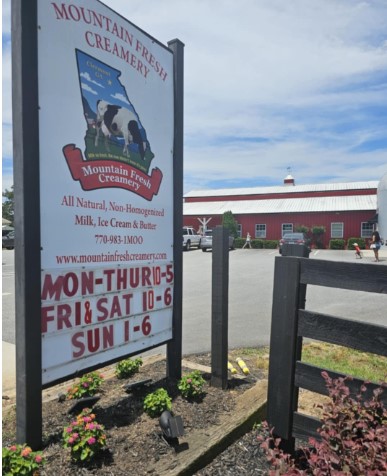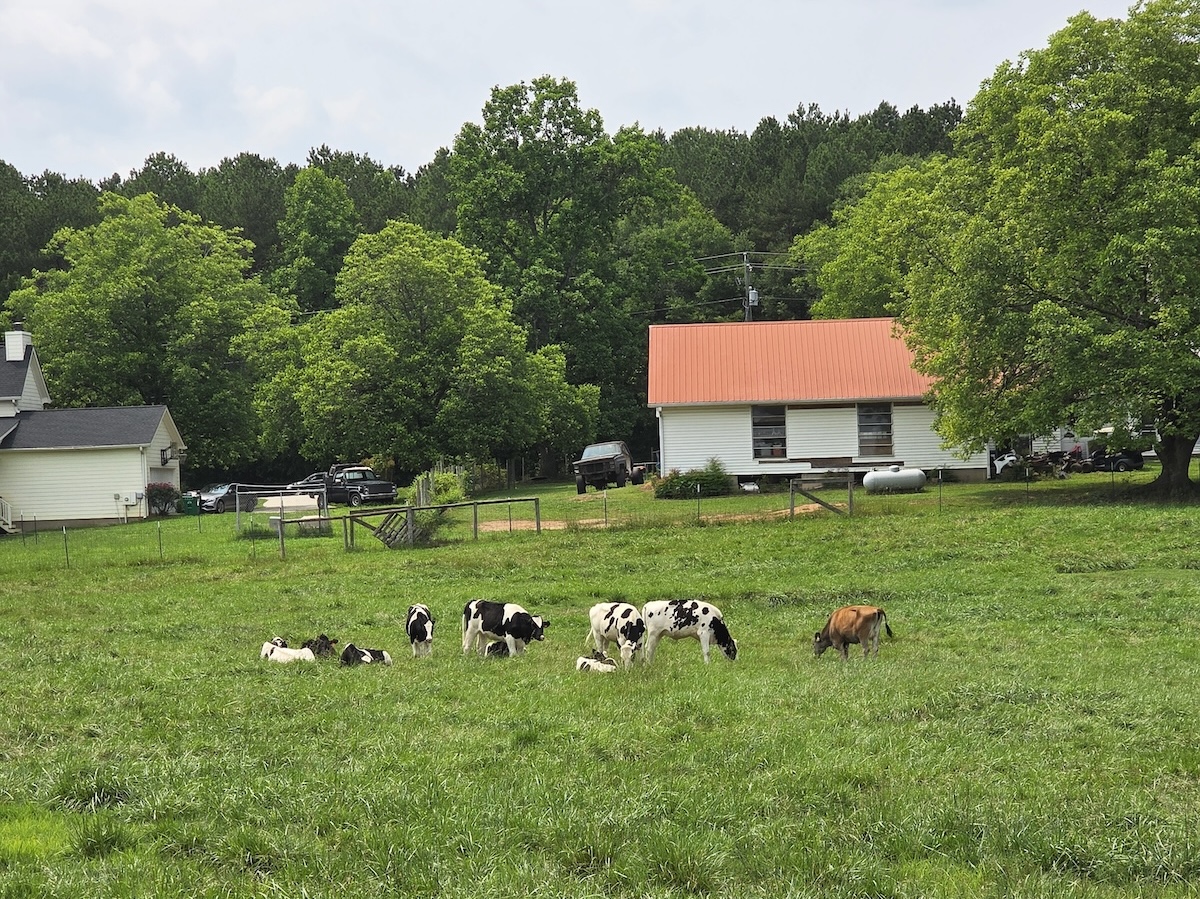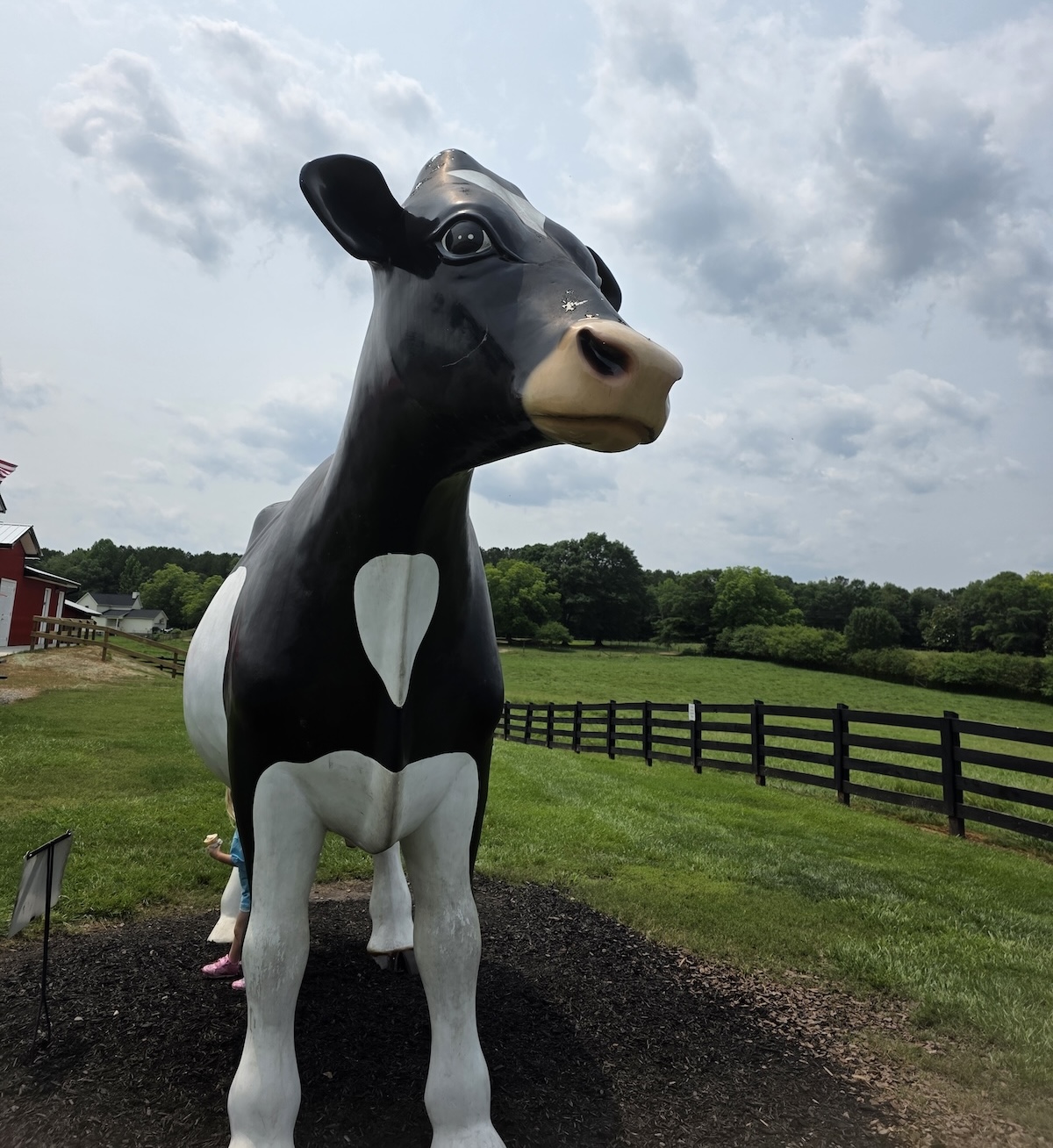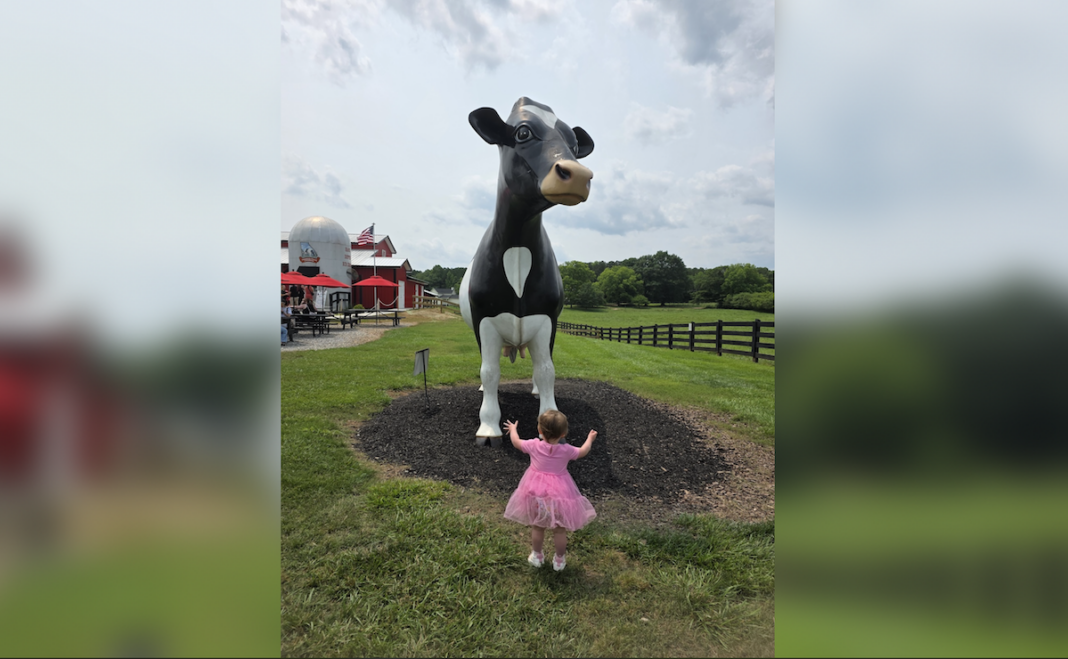On this farm roam 200 Holstein cows, living their best cow lives.
Mr. and Mrs. Glover own a farm, a 100-acre dairy operation in Clermont, Georgia. On this farm roam 200 Holstein cows, living their best cow lives. These bovines are not just residents; they are producers of some of the richest cream in Northeast, Georgia. The entire operation is whimsically overseen by Dipsy-The-Great-And-Powerful, a 16-foot-tall plaster cow, whose sagely bland gaze attracts the attention of passersby while supervising those working and playing within the grounds.
In an amusing quest to bond with the Clermont cow-overlord, I tried to capture a selfie with Dipsy but couldn’t quite fit both my face and her imposing stature into the frame. Feeling slightly defeated, I stepped aside to let a toddler dressed as Elsa have her moment in the spotlight, cheerfully sitting on the grass before Dipsy while her mother snapped a picture.
Norman Rockwell resurrected
Returning to my Kia Soul with a half-hour to spare before my interview, I took a moment to sit without my phone, embracing the near silence to meditate on my surroundings. This quiet pause evoked thoughts of the American Realism movement of the 1950s, which celebrated ordinary people experiencing simple, serene moments, often with family.

Watching the warm Georgia breeze ripple the grasses and trees, I observed a mother spreading a pink quilt as her husband stood in line for ice cream. Nearby, their little girl pointed excitedly at a cluster of tiger lilies. Clermont may not offer crystal-clear rivers, snow-tipped mountains, or pristine white sand beaches, but it provides, in spades, rich pockets of subtle, unassuming beauty.
Even as Mountain Fresh Creamery serves offerings of whole milk, low-fat milk, chocolate milk, buttermilk, cream, seasonal butter, and premium ice cream. This complements their support for local retailers and vendors such as Nora Mill Grits and Nadine’s Pimento Cheese.
It’s all about the cows
My focus shifted from the sweet family picnic on the lawn to the bustling parking lot, filled with vehicles and families predominantly from Gwinnett and Fulton County. Amidst the buzz, I heard several languages—Spanish, the distinctive twang of Good-Ole Boy, and what this southern girl guesses might be Dutch. The combination of authentically crafted, pure foods and the inexplicable allure of Dipsy’s gaze clearly has the power to draw a diverse and enthusiastic crowd.
As I entered the cherry red barn, the vibrant atmosphere propelled me immediately into shopping mode, following the firm instructions from the man-of-the-house to return with peaches and cream ice cream and their renowned white cheddar cheese. These orders I fulfilled with downright alacrity. It was then that I met Dr. Jennifer Glover, who recognized me immediately and greeted me warmly as if we were old friends.
She led me into an office and pulled out a chair for me, setting the stage for a warm and engaging discussion. We then delved into a genuine and informative conversation about the dairy industry’s past and present.

https://www.pexels.com/photo/grazing-cows-with-ear-tags-8637748/)
I quickly learned that the Glovers are first and foremost dairy farmers. They own a small business, but their true passion is the production of dairy products and the cows that create them. They live by the family maxim, “Do right by the cows and they will do right by you.” This philosophy is reflected in the exceptional care they provide to their bovine friends. Observing the lifestyle of the Glover Holsteins, it’s hard to determine who leads a more leisurely life—the cows or the University of Georgia’s bulldog mascot.
In the scorching summer heat, UGA, the bulldog, finds respite on a bed of ice, shaded and cooled by cheerleaders in an air-conditioned dog house. At Glo-Crest Dairy, the cows also receive top-notch care
tailored to their comfort: they relax under cooling blankets in a free-standing barn, reclining on soft yoga mats sprinkled with wood shavings that cushion their feet and enhance comfort. The barn is equipped with large industrial fans to keep the air circulating and cool. While cheerleaders don’t fan them, the cows bask in the praise and attention offered by the dedicated staff who meet their every need with love and care. Indeed, Mr. Glover states that by serving and stewarding his land and animals, he feels he is living out a vital part of his Christian faith.
Challenges
The Glovers are survivors. When they opened their farm in 2000, after more than a decade of saving, they were among 328 dairy farms in Georgia. Now, only 79 remain. Dairy farming in Northeast Georgia, like many parts of the country, faces a multitude of challenges that threaten its sustainability and profitability. These include economic pressures such as high feed costs, labor shortages, fluctuating market prices for milk, and competition from large-scale industrial farms.

Additionally, regulatory and health standards demand constant compliance and adaptation, adding to the operational complexities. According to an article in the College of Agricultural & Environmental Sciences, “Dropping prices and rising production costs keep forcing Georgia dairies out of business. Another 10 percent to 20 percent could close this year. In 1985, Georgia had 854 dairies. At the end of 1997, that number slipped to 442.”
The decline of dairy farms in Hall County, Georgia, provides a stark illustration of the broader challenges facing the dairy industry, influenced heavily by regulatory changes and economic conditions. In the 1970s, Hall County was home to about 30 dairy farms. Today, only one dairy remains in Hall County, with another in nearby Banks County. According to Scott Glover, “Most of these dairies were relatively small-scale operations, typically managing herds of 30 to 40 cows.”
The significant downturn in the number of dairies began when new state regulations required the installation of bulk tanks for milk storage—a substantial investment many smaller farms couldn’t afford. Previously, dairy farming had been more straightforward, with milk often collected directly into pails—a method no longer permissible.
Additionally, in the mid-to-late 1970s, environmental regulations mandated the construction of lagoons to manage runoff water, further complicating matters.
The requirement for lagoons meant that dairy farms had to invest in significant infrastructure to manage water runoff, ensuring it did not contaminate local waterways. These regulatory changes, aimed at improving food safety and environmental protection, placed a heavy burden on small dairy operations. Mr. Glover explained that this, “led many to exit the industry. It was too much work and money.”
Agri-Tourism

Yet, for some, the love of dairy farming was worth the sacrifice of meeting new state standards. That said, navigating the complexities of modern dairy farming isn’t easy, but many farmers are finding innovative ways to meet these challenges head-on. One popular strategy is embracing more customer-facing approaches to Agri-tourism. This shift allows farmers to diversify their income streams, reduce their reliance on volatile commodity markets, and build brand loyalty directly with consumers.
Agri-tourism is a win-win, providing an additional revenue source while educating the public about dairy farming. It helps foster a stronger connection between consumers and their local agricultural community. Imagine farm tours where you get to see the cows up close, dairy product tastings that let you savor the freshest milk and cheese, or even participating in fun, educational programs that shed light on the day-to-day operations of a dairy farm. Hosting events on the farm also creates a unique experience that promotes the farm’s offerings directly to the consumer.
These activities not only generate income but also create opportunities for human connections. As Dr. Jennifer Glover puts it, transparency helps build “trust in the family and product.” By opening their doors to the public, the Glovers create lasting relationships with their customers, who walk away with a greater appreciation for the hard work that goes into producing their favorite dairy products.
Farm tours at Glo-Crest Dairy are all that and more. You can see baby calves, milk a pretend cow, and explore exhibits to learn about dairy farming and the benefits of dairy in your diet. After the farm tour, drive two miles to Mountain Fresh Creamery to learn about the bottling process, non-homogenization, and low temp pasteurization, with samples of whole milk, chocolate milk, and ice cream at “The Silo.”
The critical importance of dairy
Milk consumption in the U.S. has been declining since 1975, despite population growth, due to a combination of lifestyle changes and a broader array of beverage choices. As observed by the Glovers, the rise of fast food, delivery services like Uber Eats, and the fading tradition of family dinners have lessened milk’s presence at the meal table. Health trends and the increased popularity of diets that limit dairy, such as veganism and ketogenic, have further driven consumers toward alternatives like plant-based milk. This shift is reinforced by health professionals’ growing scrutiny over dairy’s role in adult diets and concerns about lactose intolerance, prompting significant market growth for companies like Oatly that offer non-dairy products.
Scott Glover maintains that milk is a crucial component of a balanced diet, explaining that “milk packs nutritional value, providing all the nutrients necessary for life.” Organizations like the Georgia Milk Producers and the American Dairy Association of Georgia promote these benefits through educational programs and community events. They emphasize the importance of dairy in daily nutrition and support future generations in understanding dairy’s role in sustainable agriculture.
Moreover, dairy farming plays a significant role in environmental conservation, particularly in maintaining and preserving land. According to the World Wildlife Organization, “dairy farming helps conserve native grasslands and the diverse life they support. In addition, manure—when managed properly—plays a valuable role in keeping soils fertile and healthy to grow crops.”
The final product

The man of the house is a dedicated dairy consumer, frequently purchasing Glo-Crest products on his commute from Cornelia to Dahlonega. He consistently praises their unique creamy texture. Since 2004, Glo-Crest has won the prestigious “Cream of the Crop” award. As I write this, I’m fueled by Nadine’s Pimento Cheese and sipping coffee with their rich whole milk used in FarmHouse Coffee products. Their non-homogenized, low-temperature process delivers the perfect texture for ice cream or a cold glass of milk with a homemade dinner.
The Glovers, along with their dedicated staff, produce dairy products because they are true dairy people. They seek a simpler life connected with nature and aim to help you create these personal moments with your own family, all within the pleasant shade of a 16-foot milk cow.







